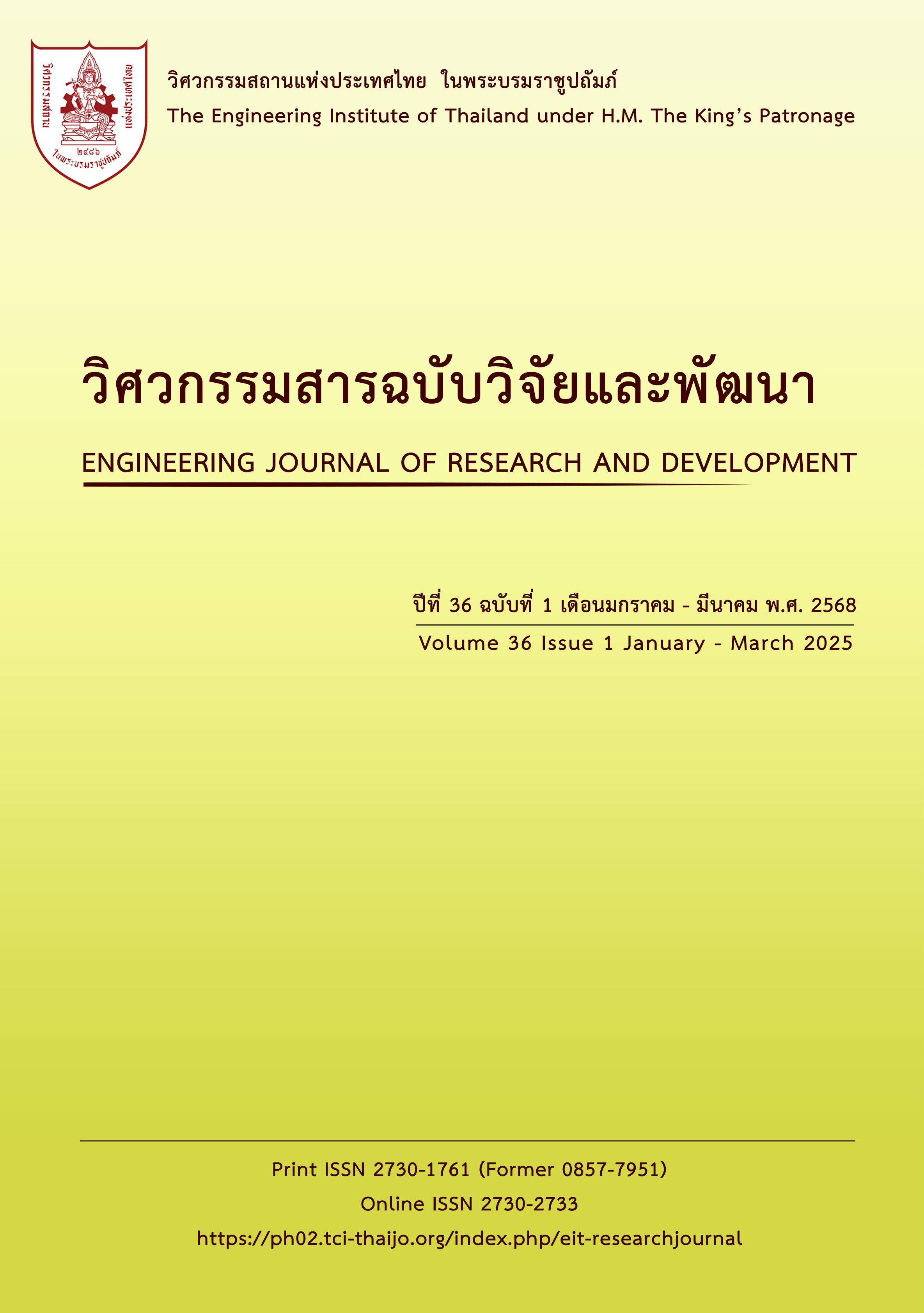PROPORTION ANALYSIS OF POLYPROPYLENE SCRAP FOR INJECTION MOLDING OF THERMOPLASTIC PARTS OF ELECTRICAL APPLIANCES
Main Article Content
Abstract
Polypropylene scrap, which is considered to be waste, frequently remains behind in the injection molding process of thermoplastic parts. Various plastic industries are interested in recycling to reduce environmental problems. The objective of this research was to analyze the proportion of polypropylene scrap that had undergone the injection molding process and pure polypropylene that still had suitable properties for injection molding into thermoplastic parts of electrical appliances. The independent variables of interest were ratio of polypropylene scrap fraction to pure polypropylene and the number of rounds of polypropylene scrap that had undergone the injection molding process. For the response variables, they were mechanical properties of thermoplastic. The acceptable recycled thermoplastic must meet mechanical criteria including the izod impact strength was greater than 126 Joule per meter (J/m), the tensile strength at yield point was greater than 23.4 megapascal (MPa) and the elongation at yield point was greater than 6.30 percent (%). The results of the study found that 1) polypropylene scrap that had undergone the injection molding process after 1 round could be used up to 50 percent by weight, 2) polypropylene scrap that had undergone the injection molding process after 2 rounds could be used up to 30 percent by weight, and 3) polypropylene scrap that had undergone the injection molding process after 3 rounds could be used up to 10 percent by weight.
Article Details

This work is licensed under a Creative Commons Attribution-NonCommercial-NoDerivatives 4.0 International License.
The published articles are copyright of the Engineering Journal of Research and Development, The Engineering Institute of Thailand Under H.M. The King's Patronage (EIT).
References
สุรีย์พร นิพิฐวิทยา. ขยะกำพร้า ขยะพลาสติก. กรุงเทพมหานคร: คณะสังคมศาสตร์ มหาวิทยาลัยศรีนครินทรวิโรฒ, 2565.
เข้าถึงได้จาก https://ir.swu.ac.th/jspui/handle/123456789/24788 [ค้นเมื่อ 20 มิถุนายน 2566].
ศูนย์เทคโนโลยีโลหะและวัสดุแห่งชาติ. พลาสติกรีไซเคิล. เข้าถึงได้จาก https://www.mtec.or.th/bioplastic/recycled-plastic/
[ค้นเมื่อ 20 มิถุนายน 2566].
Goodship, V. Plastic Recycling. Science Progress, 2007, 90 (4), pp. 245-268. DOI: https://doi.org/10.3184/003685007X228748
Tesfaw, S., Bogale, T. M. and Fatoba, O. Evaluation of tensile and flexural strength properties of virgin and recycled high-density polyethylene
(HDPE) for pipe fitting application. Materials Today: Proceedings, 2022, 62, pp. 3103-3113. DOI: https://doi.org/10.1016/j.matpr.2022.03.385
Latko-Duralek, P., Dydek, K. and Boczkowska, Thermal, Rheological and Mechanical Properties of PETG/rPETG Blends.
Journal of Polymers and the Environment, 2019, 27, pp. 2600-2606. DOI: https://doi.org/10.1007/s10924-019-01544-6
Tai, H.-S. and Yeh, J.-L. Evaluation and verification of the virgin–recycled mixing ratio of polypropylene plastic. Journal of the Chinese Institute of Engineers, 2018, 41(1), pp. 69-75. DOI: https://doi.org/10.1080/02533839.2017.1419074
Huang, P.-W. and Peng, H.-S. Number of Times Recycled and Its Effect on the Recyclability, Fluidity and Tensile Properties of Polypropylene
Injection Molded Parts. sustainability, 2021, 13 (19). DOI: https://doi.org/10.3390/su131911085
IRPC Public Company Limited. Polypropylene Impact Copolymer (ICPP) 2300NC: Technical Data Sheet, 2022.
Available from: https://polimaxx.irpc.co.th/wp-content/uploads/2022/09/pp_2300NC_20221010.pdf [Accessed 20 July 2023].
Meglio, E., Davino, A. and Formisano, A. Experimental Tests on Lightweight Cement Mortar and Concrete with Recycled Plastic Wastes.
buildings, 2023, 13 (15). DOI: https://doi.org/10.3390/buildings13051181
วิโรจน์ เตชะวิญญธรรม. งานฉีดพลาสติก. กรุงเทพมหานคร: ซีเอ็ดยูเคชั่น, 2560.
จารุนี วิวัชรโกเศศ. เอกสารมาตรฐาน ASTM. วารสารกรมวิทยาศาสตร์บริการ, 2541, 46 (147), หน้า 23-25.
เข้าถึงได้จาก http://siweb1.dss.go.th/dss_doc/dss_doc/show_discription_doc.asp?ID=1461 [ค้นเมื่อ 20 มิถุนายน 2566].
ASTM International. ASTM D256: 2010. Standard Test Methods for Determining the Izod Pendulum Impact Resistance of Plastics.
United States, 2010.
ASTM International. ASTM D638: 2014. Standard Test Method for Tensile Properties of Plastics. United States, 2014.
Kadac, K. and Nowaczyk, J. Wplyw procesu recyklinguna wlasciwosci poli (tereftalanu etylenu). Przetwórstwo Tworzyw,
, 21(4), pp. 392-332. Available from: https://www.infona.pl/resource/bwmeta1.element.baztech-b77a5b46-c988-
e2-bb05-a7c84b55dbc3/tab/summary [Accessed 18 October 2023].
บุษยมาศ วอขวา. การแปรรูปเศษเมลามีนเป็นวัตถุดิบรีไซเคิลเพื่อการพัฒนาผลิตภัณฑ์เมลามีน. วิทยานิพนธ์ปริญญาวิทยาศาสตรมหาบัณฑิต,
มหาวิทยาลัยเกษตรศาสตร์, 2559.
Siwadamrongpong, S., Mahai, M. and Wonglane, K. Study on properties of recycled materials from waste melamine.
In: South East Asian Technical University Consortium (SEATUC), KMUTT Bangkok Thailand, 6-7 March 2012.
Siwadamrongpong, S., Wonglane, K. and Mahai, M. Influence of forming temperature and waste melamine content on flexural strength
of recycled material from waste melamine. In: South East Asian Technical University Consortium (SEATUC),
Institut Teknologi Bandung Indonesia, 4-6 March 2013
Arostegui, A., Sarrionandia, M., Aurrekoetxea, J. and Urrutibeascoa, I. Effect of dissolution-based recycling on the degradation and the
mechanical properties of acrylonitrile–butadiene–styrene copolymer. Polymer Degradation and Stability, 2006, 91(11), pp. 2768-2774.

